Politics
Trump’s nuclear testing plan raises fears, confusion in Washington
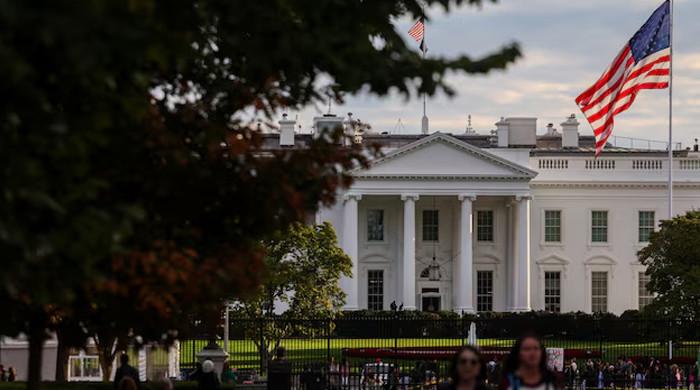
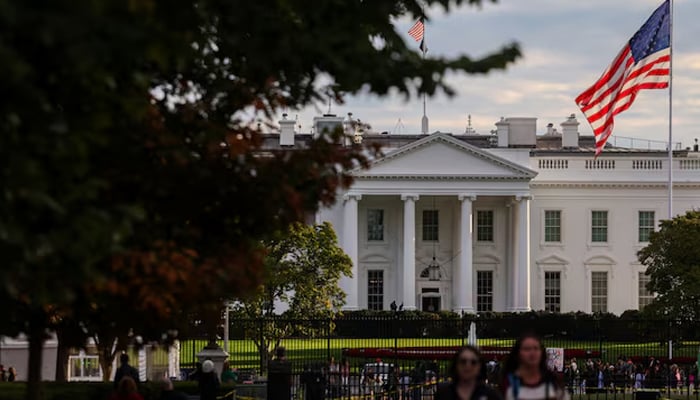
- Trump tells Pentagon to start testing nuclear weapons.
- Experts say explosion tests would be disruptive.
- Breaking moratorium on nuke tests to benefit US adversaries.
If US Navy Vice Admiral Richard Correll thought he was going to have an easy confirmation hearing on Thursday to become the commander of America’s nuclear forces, those hopes surely vanished at 9:04pm the night before he was to testify.
That was when President Donald Trump shocked the world by announcing on social media that he had asked the US military to “start testing our Nuclear Weapons”, saying the United States could not fall behind Russia and China.
“Russia is second, and China is a distant third, but will be even within 5 years,” Trump said.
During a roughly 90-minute hearing on Thursday morning at the Senate Armed Services Committee, Correll faced repeated questions about Trump’s comments from puzzled US lawmakers, embodying the confusion that the Republican president unleashed in Washington and beyond.
The top Democrat on the committee, Senator Jack Reed, asked Correll whether a resumption of US nuclear explosive testing would be destabilising, triggering a global nuclear arms race.
“If confirmed as the commander of STRATCOM, my role would be to provide military advice on any discussions on the way ahead with respect to testing,” Correll said.
The vice admiral, who Trump nominated in early September to lead the US military’s Strategic Command, or STRATCOM, which focuses on nuclear deterrence and strike capabilities, kept answering questions carefully throughout the hearing.
At one point, Senator Angus King, an independent, asked whether Trump’s post could be about testing delivery systems such as missiles rather than explosive testing of nuclear devices.
“I don’t have insight into the President’s intent. I agree that could be an interpretation,” Correll said.
US Moratorium
US officials on Thursday did not clarify whether Trump was calling for testing of nuclear weapon delivery systems or ending a 33-year moratorium on explosion tests, which experts said would be disruptive and carry the risk of provoking escalation from rivals, evoking anxious memories of the Cold War.
Vice President JD Vance said testing was part of ensuring the US nuclear arsenal functions properly.
The US and other nuclear powers have long stopped detonating actual nuclear warheads and instead use advanced computer simulations to maintain the readiness of their arsenals.
“There is no good reason for the United States to resume explosive nuclear testing — it would actually make everyone in the US less safe,” said Tara Drozdenko, director of the global security program at Union of Concerned Scientists.
“The US has so much to lose and so little to gain from resuming testing,” she said.
Sending a message to Moscow and Beijing
Many analysts said that Trump, who often tries to project strength as a negotiation tactic, likely was seeking to send a message to Moscow and Beijing.
In his social media post issued ahead of his meeting with Chinese President Xi Jinping in South Korea, the president said he had instructed the Pentagon to start testing “on an equal basis” and added, “That process will start immediately.”
Only North Korea has conducted a nuclear test explosion in this century, the last in 2017.
Russia, which has tested two new nuclear-powered weapons in recent days, has been accused by Washington of conducting so-called low-yield tests and of lacking transparency in its nuclear program, but has not conducted a full-scale nuclear explosion.
Russian President Vladimir Putin had cautioned that if any country tested a nuclear weapon, then Moscow would too, a Kremlin spokesperson said on Thursday.
China has repeatedly rebuffed efforts across US administrations to hold talks on nuclear arms. While Beijing is undertaking efforts to dramatically increase its nuclear weapons stockpiles it has expressed little interest in negotiating with Russia and the US, arguing those countries’ nuclear forces are currently considerably larger.
“If the goal is to generate leverage to force China to negotiate, I think that’s unlikely to work,” said James Acton, co-director of the nuclear policy program at the Carnegie Endowment for International Peace.
China hopes the US will abide by its commitment to a moratorium on nuclear testing and obligations under a test ban treaty, Beijing’s foreign ministry said on Thursday.
Benefiting US adversaries
Breaking the moratorium on US nuclear tests could benefit Washington’s nuclear rivals by allowing them to conduct more tests, said Ploughshares, a foundation focused on reducing nuclear threats.
The United States has conducted the majority of all nuclear test explosions and retains data gathered from its 1,030 tests since 1945.
STRATCOM, where Correll is the current No 2, had just certified the US military’s nuclear arsenal in January.
“A return to testing will benefit US adversaries by allowing them to catch up in nuclear research and weapons development,” Ploughshares said in a statement.
A source at the Department of Energy, who spoke on condition of anonymity, said any test would take place deep underground at a Nevada site, which is mandated to be ready to conduct tests within 36 months.
At the hearing, Senator Jacky Rosen said her home state of Nevada had suffered from being the site of US nuclear explosive tests from 1951 to 1992, and vowed to prevent Trump from resuming them: “I’m going to be crystal clear: I will not let this happen. Not on my watch.”
Politics
Trump’s ‘Presidential Walk of Fame’ at White House features mocking, controversial plaques targeting former presidents
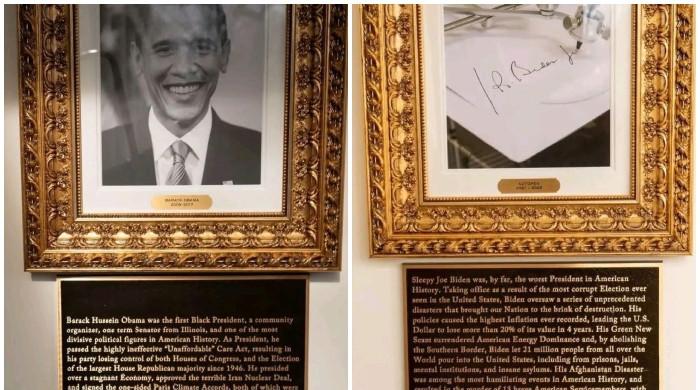
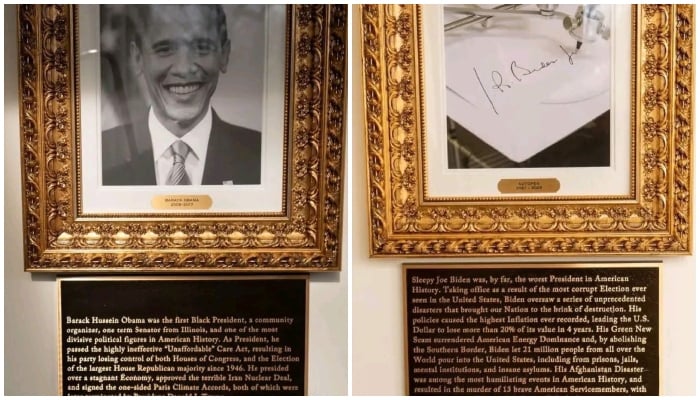
WASHINGTON: US President Donald Trump has installed new plaques at the “Presidential Walk of Fame” located along the West Wing Colonnade of the White House.
The plaques contain direct and politically charged, mocking commentary aimed at recent former US presidents. Reporters spotted the new additions on Wednesday, triggering fresh debate within Washington’s political circles.
One plaque refers to former president Joe Biden as “Sleepy Joe Biden” and labels him “the worst president in American history.” Notably, Biden’s portrait is absent from the walk of fame. Instead, a framed image shows Biden’s signature produced by the presidential autopen.
Former president Barack Obama’s plaque identifies him as “Barack Hussein Obama” and describes him as “one of the most divisive political figures in American history.”
Similarly, the plaque beneath Bill Clinton’s portrait states that “in 2016, President Clinton’s wife, Hillary Clinton, lost the presidency to President Donald J. Trump.”
According to the White House, several of these plaques were written by President Trump himself. These additions are being described as part of Trump’s broader effort to reshape the White House in line with his political vision.
The White House formally unveiled the Presidential Walk of Fame outside the Oval Office in September. The display includes portraits of all past US presidents, with the exception of Joe Biden.
President Trump has previously overseen other major changes at the White House, including replacing the grass in the Rose Garden with a stone patio and ordering the construction of a new White House ballroom, a project that required the demolition of much of the East Wing.
Political analysts say the plaques represent an unprecedented move in American history, marking the first time such overtly political and controversial narratives about former presidents have been publicly displayed inside the White House. Strong reactions and further debate are expected in the coming days.
Politics
Three killed in Taipei metro attacks, suspect dead
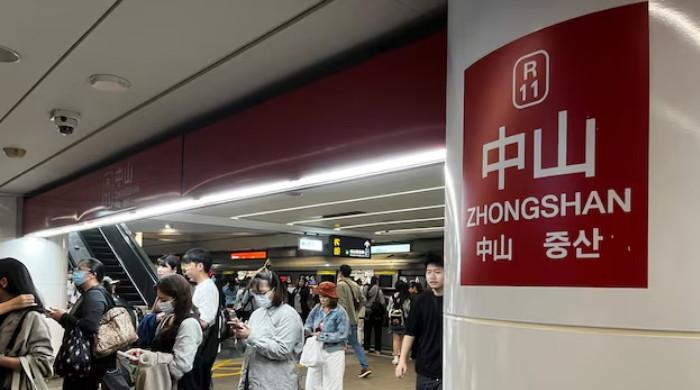

Attacks at metro stations in Taipei on Friday involving smoke bombs and stabbings killed at least three people, the Taiwanese city’s fire department said, adding that the suspect was also dead.
Taiwan’s Premier Cho Jung-tai said the attacks at Taipei Main Station and Zhongshan Station were “a deliberate act”, although the motive was not immediately clear.
Cho said in a statement that the suspect wore a mask and threw “five or six gasoline bombs or smoke grenades” at Taipei Main Station.
According to the Taipei City Fire Department, a total of four people were confirmed dead, including the suspect, a 27-year-old man.
Five other people were injured, the fire department said.
The city’s mayor said the suspect had apparently jumped off a building and that he was wanted for evading military service.
One of the victims was killed while trying to stop the attack at the Main Station, Mayor Chiang Wan-an told reporters.
“Unfortunately, he was attacked and passed away… we are all deeply saddened,” he said.
A witness of the attack at the Main Station told local network EBC News that he had seen a “man rush up and try and subdue” the attacker, who was “wearing a gas mask and a bulletproof vest”.
“At first I thought it was a drill, then I saw a person holding a knife and throwing smoke grenades,” said the witness, who did not give his name.
The mayor said that “we understand that the suspect committed suicide by jumping from a building to evade arrest, and has been confirmed dead.”
High alert
A second witness told EBC News that “someone ran out wearing a gas mask and started throwing canisters that released gas.”
“I quickly ran away. He kept throwing them behind me. I didn’t count how many (canisters) but there was a constant banging and clanging sound,” added the witness, who also did not give his name.
“I didn’t hear any explosions, but a lot of gas kept spraying out.”
Cho, the island’s premier, earlier said three people suffered cardiac arrest as a result of the attacks, and several people had “injuries from stab wounds and blunt force trauma to various parts of their bodies”.
Authorities said they were ramping up security across the island in response to the attacks.
“All important locations… including railway stations, highways, subway stations and airports are maintaining a high level of alert and vigilance,” Cho told reporters.
Images released by Taiwan’s Central News Agency show a canister on the ground at the Main Station, with officers examining potential evidence at the scene.
A video posted on social media shows a thick cloud of white smoke covering an underground section of a metro station, with some people standing at a distance.
President Lai Ching-te said Taiwanese authorities will “quickly clarify the details of the case. There will be no leniency and we will do everything in our power to ensure the safety of our citizens.”
Violent crime is rare Taiwan, though an attack in 2014 horrified the normally peaceful island when a man went on a stabbing spree on Taipei’s metro, killing four people. He was executed for the killings in 2016.
Politics
Body of Bangladesh’s youth leader reaches Dhaka amid ‘violent protests’
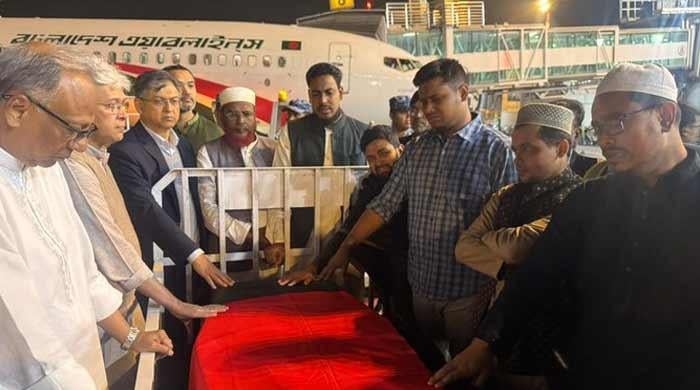
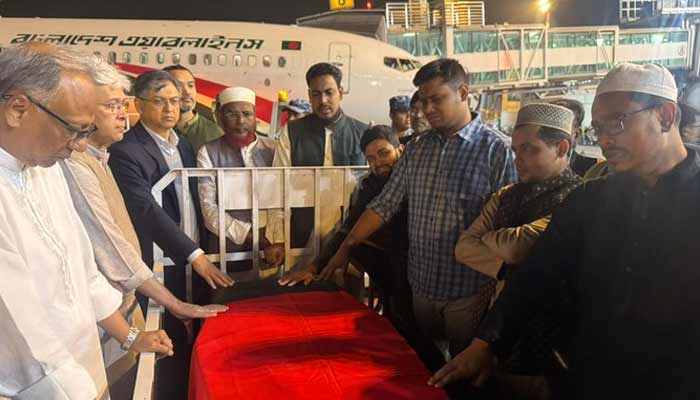
- Bangladeshis urged to resist violence committed by “fringe elements”.
- Mobs vandalise media offices, attack Indian High Commission.
- Violence to continue if justice not ensured, says activist.
The body of Osman Hadi, the popular student leader who was assassinated in Dhaka last Friday while launching his campaign for the elections, has reached the Bangladesh’s capital amid ongoing nationwide violent protests.
In a post on X, the interim government said a Biman Bangladesh Airlines flight carrying Sharif Osman Hadi’s remains landed at Hazrat Shahjalal International Airport in Dhaka at 5:48pm local time after departing from Singapore, where he was undergoing medical treatment.
Meanwhile, the interim administration urged people to resist violence as soldiers and police fanned out across Dhaka and other cities following protests, sparking fears of more unrest ahead of national elections in which he had been due to run.
The Muslim-majority nation of about 175 million people is due to elect a new parliament in less than two months’ time — a transition many hope will help the country recover from nearly two years of instability and reclaim its position as a South Asian development success story.
Frequent bouts of violent protests and political wrangling among disparate groups including hardliners have, however, punctured the national sense of euphoria that arose after student-led protests ousted powerful leader and longtime Prime Minister Sheikh Hasina in August 2024.
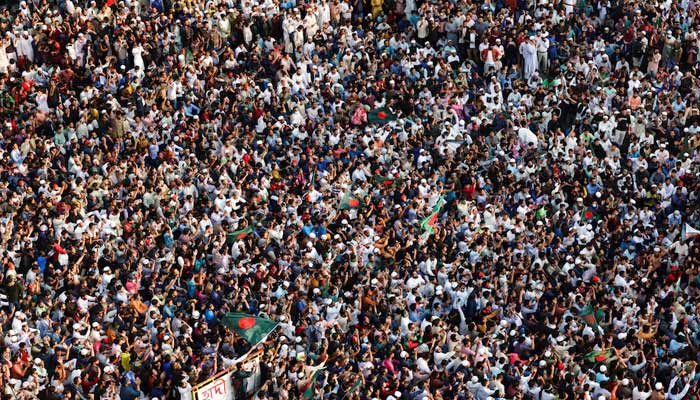
It has also exposed the limitations of the interim government headed by Nobel laureate Muhammad Yunus, analysts said, raising questions over his grip on governance in the world’s second-largest apparel producer after China.
Hasina’s party, the Awami League, which has been barred from the February 12 vote, has threatened unrest that some fear could derail the election itself.
Newspaper, Indian mission targeted
Youth leader Sharif Osman Hadi, 32, was shot in the head by masked assailants in Dhaka last Friday while launching his campaign for the elections. He was a spokesperson for the Inquilab Mancha, or Platform for Revolution, and participated in the protests that overthrew Hasina.
Hadi, an outspoken critic of India as well, was initially treated at a local hospital before being flown to Singapore for advanced medical care, where he died after six days on life support.
In Dhaka, videos circulating on social media showed mobs vandalising the offices of the country’s largest daily newspaper, Prothom Alo, as well as the Daily Star, on Thursday night.
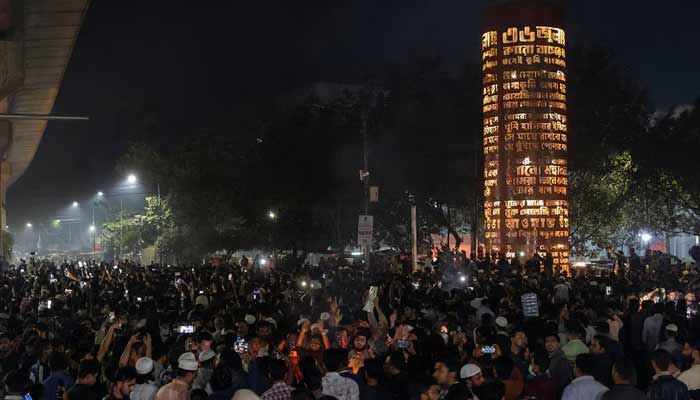
The fire service said the blaze at the Daily Star was under control. Troops were deployed to the scene, and firefighters rescued journalists trapped inside the building.
Violence was also reported in a number of cities across Bangladesh, including the port city of Chittagong, where protesters attacked the Indian Assistant High Commission.
The unrest follows fresh anti-India protests this week, with ties between the neighbours deteriorating since Hasina fled to Delhi. On Wednesday, hundreds of demonstrators marched toward the Indian High Commission in Dhaka, chanting anti-India slogans and demanding Hasina’s return.
Although calm had returned to much of the country on Friday morning, protesters carrying national flags and placards continued demonstrating at Shahbagh in central Dhaka, chanting slogans and vowing not to return until justice was served.
Government blames ‘fringe elements’
The interim government urged the people of Bangladesh to resist all forms of mob violence, it said were committed by a “few fringe elements”.
“This is a critical moment in our nation’s history when we are making a historic democratic transition,” it said in a statement. “We cannot and must not allow it to be derailed by those few who thrive on chaos and reject peace.”
The government told journalists at the Daily Star, Prothom Alo and New Age following the attacks on their offices that, “attacks on journalists are attacks on truth itself. We promise you full justice”.
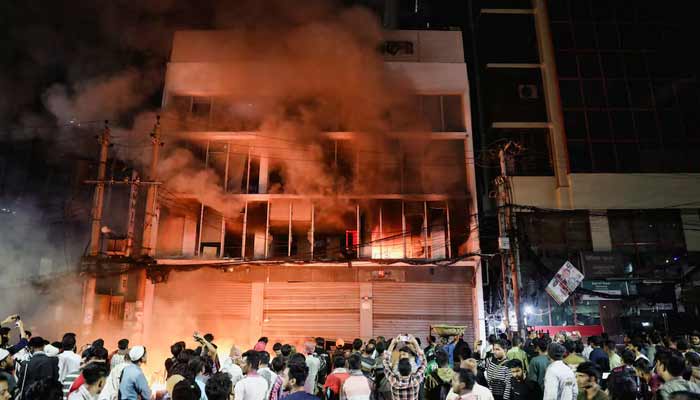
It also condemned the lynching of a Hindu man in Mymensingh district, who was beaten and set on fire over allegations of blasphemy in an unrelated incident, vowing that those responsible would be brought to justice.
Independent rights group Ain O Salish Kendra said in a statement that coordinated attacks on media outlets, cultural institutions and historical sites indicated the dangerous spread of extremist and violent thought in Bangladesh.
“This series of violence may remain a permanent crisis for the country’s human rights situation, democratic space and future generations,” if justice is not ensured and institutions protected, it said.
-

 Business6 days ago
Business6 days agoHitting The ‘High Notes’ In Ties: Nepal Set To Lift Ban On Indian Bills Above ₹100
-

 Politics1 week ago
Politics1 week agoTrump launches gold card programme for expedited visas with a $1m price tag
-

 Sports1 week ago
Sports1 week agoU.S. House passes bill to combat stadium drones
-

 Fashion1 week ago
Fashion1 week agoTommy Hilfiger appoints Sergio Pérez as global menswear ambassador
-

 Sports1 week ago
Sports1 week agoPolice detain Michigan head football coach Sherrone Moore after firing, salacious details emerge: report
-

 Business1 week ago
Business1 week agoCoca-Cola taps COO Henrique Braun to replace James Quincey as CEO in 2026
-

 Fashion1 week ago
Fashion1 week agoBrunello Cucinelli lifts 2025 revenue growth forecast to up to 12%
-
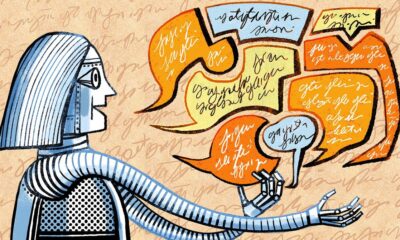
 Tech6 days ago
Tech6 days agoFor the First Time, AI Analyzes Language as Well as a Human Expert






